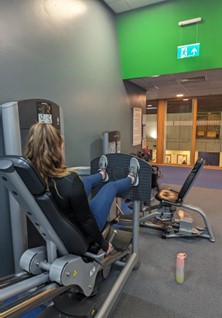Join our mailing list
Get the latest on our campaigns, news and events from Thomas Pocklington Trust by joining our mailing list
Belle Whiteley is a 24-year-old partially sighted gym user and following the recent release of the ‘Accessibility and Disability Support Across the Leisure and Fitness Sector’ report, she reflects on her own experiences of using a gym.
The report, commissioned by TPT and undertaken by All Able Ltd, is a detailed look at the state of the nation’s leisure centres and how they serve blind and partially sighted customers.
It recommends an accessible-design approach for leisure centres. That includes updates to websites accessibility information, extensive accessibility testing and collaboration with suppliers who prioritise accessibility.
“First of all, for me finding a gym to go to was easy but this is because a close friend of mine is a personal trainer at a local gym.
I had a positive experience when using the gym. The gym staff have been really helpful, as well as other gym members who often assist me when it comes to adjusting things like the weight setting. Before joining the gym, I also had a lengthy induction which assisted me with each piece of equipment, and as importantly, familiarising myself with the gym layout.
“It is important for me to go to the gym for my physical health. I struggle to motivate myself at home but being in the gym environment pushes me to exercise. Additionally, it improves my mental health by getting me out of the house and giving me a sense of achievement after each session.”
Belle started as a Sight Loss Council volunteer for Thomas Pocklington Trust and now works full time as a Sight Loss Council Coordinator covering the Yorkshire and Humberside regions.
“Going to the gym has helped me to feel more confident about myself and my body which in turn makes me feel more positive in social interactions and public settings. My job involves a lot of interaction with volunteers and external organisations so being more socially confident has been most helpful.
 What I want is for other blind and partially sighted people to have similar experiences to mine. So, I encourage gyms and leisure operators to implement recent recommendations from the report to make gyms and leisure centres accessible for blind and partially sighted people.
What I want is for other blind and partially sighted people to have similar experiences to mine. So, I encourage gyms and leisure operators to implement recent recommendations from the report to make gyms and leisure centres accessible for blind and partially sighted people.
I have experienced a person-centric approach to my experience of using the gym, and I would hope that this can be repeated for all gym users. Accessibility barriers aren’t hard or costly to break down. It is often simple steps that can be taken to minimise those barriers. Making the journey to becoming physically active should always be accessible to everyone.
Be open and honest about your support needs. Staff and even members of the public are so often willing to help and make sure you get the most out of the gym. Working together can make anything happen.”